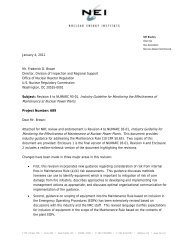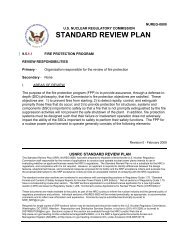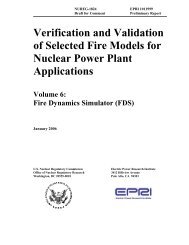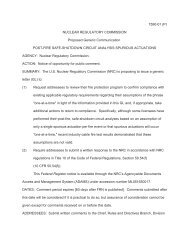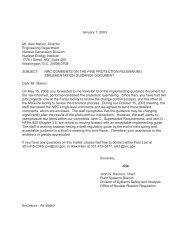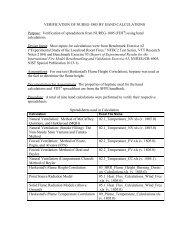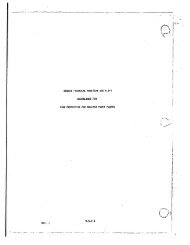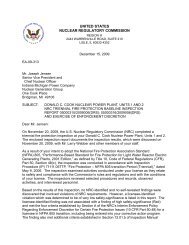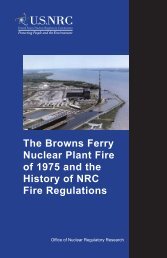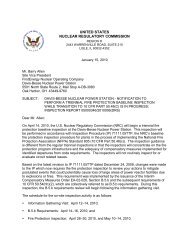NUREG/CR-6850, Volume 1 - NRC
NUREG/CR-6850, Volume 1 - NRC
NUREG/CR-6850, Volume 1 - NRC
You also want an ePaper? Increase the reach of your titles
YUMPU automatically turns print PDFs into web optimized ePapers that Google loves.
Overview of the Fire PRA Methodology2.3.2.1 Proper Polarity Three-Phase Hot Shorts on AC Power ConductorsIn developing analysis rules for three-phase proper polarity hot shorts, three cases wereconsidered and an approach for each case developed. The three cases are summarized below.Detailed discussions are provided in the associated analysis task procedures.Case 1: Grounded AC System with Thermoset-Insulated Cable: Three-phase proper polarity hotshorts are evaluated as extremely low probability events for grounded three-phase AC powersystems. It is the opinion of the Technical Development Teams that this failure mode is not risksignificant. It is recommended that this failure mode not be included in the Fire PRA cableselection process for grounded three-phase AC circuits involving thermoset-insulated cable.Case 2: Ungrounded AC System or Thermoplastic-Insulated Cable: For ungrounded systemsand thermoplastic-insulated cable, it can be reasoned that three-phase proper polarity hot shortsare of low probability, but not as low as that for grounded systems with thermoset cable (Case 1).It cannot be conservatively argued that the failure mode likelihood is low enough to screen outfor all cases. It is recommended that for these configurations, three-phase proper polarity hotshorts should be considered only for high consequence equipment. See volume 2, section 2.5.6for the definition of high consequence equipment.Case 3: Armored Cable or Cable in Dedicated Conduit: Three-phase proper polarity faults arenot considered credible for armored power cables or for a single triplex cable in a dedicatedconduit.2.3.2.2 Circuit Selection and Analysis – System-Wide Safety Signals.The systematic treatment of system-wide safety signals (e.g., safety injection, containmentisolation, feedwater actuation, etc.) is difficult. These signals are manifested as auxiliary contactswithin the control circuits of important plant equipment. Integrating logic combinations ofinstrument circuit failures that might trigger a safety signal in the context of scenario specificfailure modes exceeds the capability of analytical tools generally available to a plant (forexample, rolling up the combined instrument circuit failures of a two-out-of-three logic networkfor a containment isolation signal). Consequently, this aspect of circuit analysis is treatedqualitatively, rather than quantitatively, in this report.2.3.2.3 Multiple High-Impedance FaultsThe recommended method does not include quantitative assessment of multiple high-impedancefaults that may cause circuit protection features to activate (e.g., breaker opens or fuse blows)above the first level of electrical protection for the cables assumed to be threatened by the fire.The multiple high impedance fault mode for electrical power circuits is considered to be of avery low likelihood based on:• The narrow range of fault quality (i.e., insulation resistance of the fault) needed to createa sustained fault current below the first level of circuit protection, and2-8





